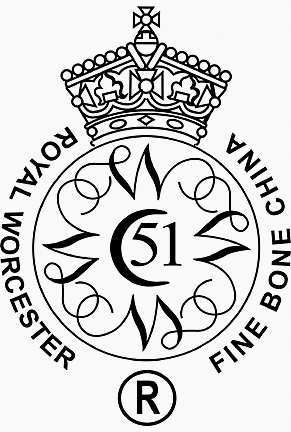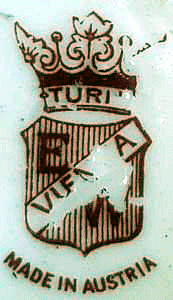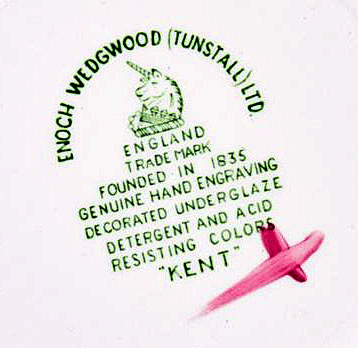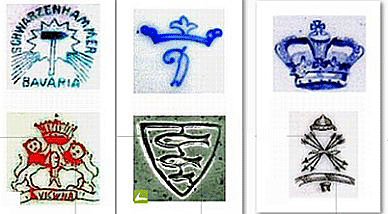 An
experienced collector of pottery can tell a lot about a piece’s origin
by reading the manufacturers' marks on the bottom of each piece. These
marks tell the pottery's name, its location, its company symbol, and
often the pattern name or the name given to the body shape of the piece.
An
experienced collector of pottery can tell a lot about a piece’s origin
by reading the manufacturers' marks on the bottom of each piece. These
marks tell the pottery's name, its location, its company symbol, and
often the pattern name or the name given to the body shape of the piece.
But there may also be other, less obvious, marks that indicate the
method of production or factory flaws that show the level of quality
control used by the firm. Collectors familiar with these signs can
quickly distinguish between factory flaws and more serious indicators of
damage and wear inflicted upon that same piece once it has left the
factory. Knowing the difference allows the experienced collector to
purchase pottery with confidence.
 While
most manufacturer’s marks, which may he printed, incised, impressed,
stamped, or applied as paper labels, usually contain the pottery’s name,
initials, symbol and location---or some combination of these—some are
rather sparse and may only contain a letter within a geometric shape or
a crest.
While
most manufacturer’s marks, which may he printed, incised, impressed,
stamped, or applied as paper labels, usually contain the pottery’s name,
initials, symbol and location---or some combination of these—some are
rather sparse and may only contain a letter within a geometric shape or
a crest.
In the case of the larger firms, a pottery mark also has publicity value
and shows the buyer that a long-established company with a reputation to
uphold has made a piece. Such clear name marks include Wedgwood,
Minton, Royal Crown Derby, Royal Doulton, and Royal Worcester in Britain
and Bennington, McCoy, and Hull in the U.S.
Though these marks are one of the best and easiest ways to identify
ceramics, the shear number of them makes it impossible to know every mark.
Additionally, many small firms either saw no reason to use marks or
sometimes used marks that haven’t been identified because of the short
life span and limited production of the company.
 To
the collector a pottery mark can also identify the manufacturer and help
establish the approximate date of manufacture and in several cases the
exact year of production, particularly in the case of 19th and 20th
century wares from the leading firms which employed private dating
systems. With the increasing use of ceramic marks in the 19th century, a
large proportion of English and American pottery and porcelain can be
accurately identified and often dated.
To
the collector a pottery mark can also identify the manufacturer and help
establish the approximate date of manufacture and in several cases the
exact year of production, particularly in the case of 19th and 20th
century wares from the leading firms which employed private dating
systems. With the increasing use of ceramic marks in the 19th century, a
large proportion of English and American pottery and porcelain can be
accurately identified and often dated.
Pottery’s added marks to their wares in several ways. Potters could incise
them into the soft clay before the piece air dried, in which the mark
will show a slight ploughed-up effect. Potters often do this to handmade
pieces. Some manufacturers of quantity pieces, such as Wedgwood,
impressed a mark into the soft clay using a metal or clay stamp or seal.
Many pottery manufacturers used painted marks—usually containing their
name or initial—added over the glaze at the time of decoration. Some
used stencils.

 Lastly,
most 19th-century pottery makers used printed marks transferred from
engraved copper plates at the time of decoration, often in blue under
the glaze when the main design is also underglaze blue.
Lastly,
most 19th-century pottery makers used printed marks transferred from
engraved copper plates at the time of decoration, often in blue under
the glaze when the main design is also underglaze blue.
Pottery marks weren’t always universally used. In 1890, President
William McKinley introduced the McKinley Tariff Act that imposed tariffs
on many imports, including pottery, so that American manufacturers could
more easily sell their products. The Act required that all such imports
show the name of country of manufacture, such as “England,” “Germany,”
“Nippon,” or “France.” In 1921, an amendment to the Act required that
the phrase “Made in” precede the country of origin, such as “Made in
England” or “Made in Japan.” However, some foreign companies began using
the phrase as early as 1898. This is a great way for collectors to date
foreign-made pieces.

Beginning pottery collectors often miss marks or flaws from
manufacturing and instead focus only on the maker’s mark. These marks
give clues to the quality of the ceramic bodies each maker used.
Potteries used different firing techniques for different grades of
ceramics and the distinctive marks each technique left behind, once
known, help to establish the quality of a piece.
< Back to Collecting Archives
Next Article >
